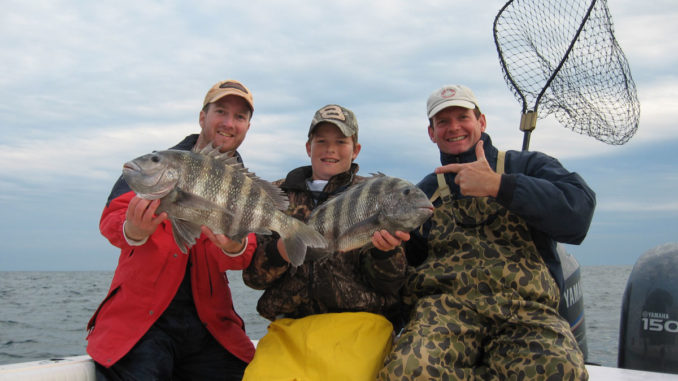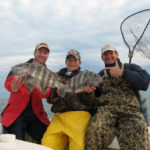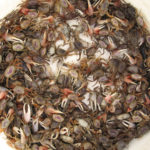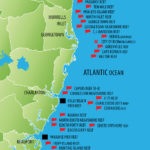
Get on the right nearshore structure and fill up a cooler with tasty sheepshead
A stubborn chill hung in the air, and the anglers aboard Capt. Rick Percy’s boat were anxious for the sun to the same. Percy was watching his depth finder, looking for a certain piece of structure on the Fish America Reef, and finding it, he pushed a button on his trolling motor’s remote control, and reached for the bucket of fiddler crabs.
Percy, who operates Reel Chance Fishing Charters out of Beaufort, was anchored down over one of his favorite sheepshead spots.
“Anchoring is one of the biggest challenges when fishing these reefs, especially for sheepshead,” said Percy. “These fish will concentrate on one piece of structure and feed exactly in that spot. If you are a few feet off the mark, you might as well be fishing 300 feet in the wrong direction.”
Anglers without GPS-enabled trolling motors like Percy’s i-Pilot have it much worse. They have to toss out an anchor, let the boat settle in the current and wind, wait for the anchor to catch, hope it holds, then hope the boat rests in the spot they were hoping for. If they’re off the mark, they need to pull up the anchor and reset, lest they be fishing 300 feet in the wrong direction as Percy mentioned.
Reefs like this one and the Betsy Ross are within sight of the beaches of Hilton Head Island, but the fishing is a lot different than inshore, especially this time of year. Where fishing for sheepshead can be especially tough inshore during the winter, the reefs are full of activity and fish, and Percy will head out, weather permitting, any day he can.
“The sheepshead, along with plenty of other species, really stack up on these reefs this time of year,” said Percy, who uses fiddler crabs for bait on Carolina rigs with the smallest weight he can get by with, . He uses the smallest amount of weight he needs but said that changes with the tide and current. He tries to keep it fish a 1-ounce sinker or lighter, but he’ll go up to 2 ounces or more if necessary.
Percy (803-535-6166) mentioned another challenge to anglers fishing for sheepshead here this month, but this one doesn’t have an easy solution.
“Keeping black sea bass off your hooks so you can catch a sheepshead is probably the biggest challenge for anglers,” he said, and anyone who’s fished nearshore can attest to that.
Percy finds that the faster anglers can get their baits off the bottom, the fewer black sea bass they usually catch.
“I drop my bait down and try to reel up a few turns as soon as it hits the bottom. I find that the sea bass feed on the bottom more so than in the water column like sheepshead usually do,” he said. Still, anglers will catch their share of sea bass.
Capt. Jim Dodge of Charleston Fishing Guide Service agrees with Percy on all accounts, even though he does his sheepshead fishing out of Charleston at places like Capers Reef. When he first started fishing reefs for sheepshead, he tried the “this is close enough” mentality for anchoring that Percy warns against. He quickly found it doesn’t work and now will spend as much time as necessary to make sure he is anchored properly, even if that involves pulling up and resetting the anchor several times.
Dodge uses plenty of fiddler crabs, but he also uses oyster meat, and he isn’t shy about putting both baits on a hook at the same time.
“I want to attract the bigger sheepshead, so I want a big bait. I also know the sea bass are going to pick at it, so I want enough bait on the hook to make it through that and still look enticing to sheepshead,” he said.
Both Percy and Dodge agree that detecting a sheepshead bite is a lot easier on these reefs than it is inshore, where most anglers have a difficult time catching these fish until they get the hang of it. These fish bite very quick and light while inshore, and most inshore anglers have heard — or said — that you have to set the hook before a sheepshead bites or you’ll never catch one. On the reefs, it’s a different story. These fish are usually bigger, have more competition and are more aggressive than their inshore counterparts. This is good news for anglers, who have less trouble feeling the bite while fishing on these reefs.
Fiddler crabs are definitely a favorite bait, but they will also bite shrimp and oyster meat. Dodge (843-906-1622) likes using oyster meat because it is tougher and may catch several sheepshead before it has to be replaced.
Knowing how to read good electronics is a key to getting on winter sheepshead. Since boat position is so important, it is important for anglers to know what they are looking at on their depth finders. But hovering over a reef doesn’t always mean you’re in the best spot. And as the current and wind changes throughout a tide cycle, the boat will shift continually.
“Some trial and error is still involved, but if you’re on top of the reef, that’s half the battle,” said Dodge, who likes to see vertical structure on his depth finder. “If something like a smokestack of a ship or a tall concrete barrier is visible, I want to be able to get bait beside that, so I want to anchor with that in mind.”
One mistake many anglers make is just dropping their bait straight down and leaving it on the bottom, Percy said, and that leads to getting hooked on the structure too often or attracting black sea bass.
“You can often see where fish are concentrating on the depth finder. This should help determine how far to reel up after your bait hits the bottom,” he said.
Another Percy tip is not to let your line go slack.
“If your line is slack, you will never feel the bite,” he said. “This applies even when dropping the bait down, because many times, fish will bite your bait as it is falling and before it ever hits the bottom.”
A seasoned angler lowers his bait while keeping a little tension on the line, feels his weight hit the bottom, cranks the handle a few turns, feels a bite, and then sets the hook. It sounds simple, but that’s how it should go.
Percy and Dodge both use similar gear when fishing the sheepshead reefs. Medium to medium-heavy 6-foot-6 to 7-foot-6 rods are standard, mated with 2000 to 2500 class spinning reels or 4000 to 5500 class baitcasting reels. Line in the 20- to 30-pound class is sufficient, with 1/0 to 3/0 hooks best suited to sheepshead.
DESTINATION INFORMATION
HOW TO GET THERE/WHEN TO GO — The reefs off the coast of South Carolina’s Lowcountry can be accessed from any boat landing along the coast, all of which can be easily reached from US 17. The Isle of Palms Marina, Shem Creek, Russ Point and Parris Island landings all offer easy access to the reefs. Sheepshead fishing on the reefs can be great from January through March before the water warms and fish start to move back inshore.
TACKLE/TECHNIQUES — Medium to medium-heavy baitcasting or spinning outfits featuring fast tips are standard for fishing with fiddler crabs, live shrimp or oyster meat. Carolina-rigs with egg sinkers in the 1- to 3-ounce range are typical. 20 to 30-lb test fishing line and 1/0 to 3/0 hooks are good bets.
FISHING INFO/GUIDES — Capt. Robert Olsen, Knot@Work Charters, Charleston, 843-442-7724; Capt. Rick Percy, Reel Chance Charters, Beaufort, 803-535-6166; Capt. Jim Dodge, Charleston Fishing Guide, Charleston, 843-906-1622; Capt. Rob Bennett, Lowcountry Inshore Charters, Kiawah, 843-367-3777. See also Guides and Charters in Classifieds.
ACCOMMODATIONS — Harbour View Inn, Charleston, 843-853-8439; Francis Marion Hotel, Charleston, 843-722-0600; La Quinta Inn and Suites, Charleston, 843-556-5200; Hilton Garden Inn, Beaufort, 843-379-9800; Best Western Sea Island, Beaufort, 843-522-2090.
MAPS — Delorme Atlas and Gazetteer, http://www.delorme.com/, 800-561-5105; Capt. Segull’s Nautical Charts, 888-473-4855, www.captainsegullcharts.com; Sealake Fishing; Guides, 800-411-0185, www.thegoodspots.com.






